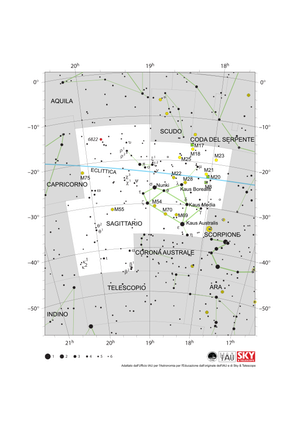Termine del Glossario Buco nero supermassiccio
Descrizione Come suggerisce il termine, i buchi neri supermassicci (SMBH) sono la classe più grande di buchi neri, con masse che vanno da milioni a miliardi di volte la massa del Sole. I dati osservativi suggeriscono che tutte le grandi galassie sembrano ospitare un SMBH al loro centro. La Via Lattea ospita un SMBH con una massa di circa 4,5 milioni di volte quella del Sole e un diametro di circa 40 milioni di chilometri. La grande quantità di massa in un piccolo volume fa sì che i buchi neri abbiano campi gravitazionali immensi (buche di potenziale gravitazionale profonde). Nel 2019, gli scienziati hanno utilizzato i dati di una rete di radiotelescopi situati in tutto il mondo per costruire un'immagine dell'orizzonte degli eventi del SMBH (6,5 miliardi di volte più massiccio del Sole) al centro della galassia M87, situata a poco più di 50 milioni di anni luce di distanza.
Termini correlati
Vedi questo termine in altre lingue
status del termine e della definizione La definizione originale di questo termine in inglese é stata approvata da un ricercatore astronomo e da un docente La traduzione di questo termine e della sua definizione sono ancora in attesa di approvazione
Il Glossario Multilingue OAE é un progetto dell'Ufficio IAU per la didatticadell'astronomia (OAE) in collaborazione con l'ufficio IAU OAO per la DivulgazioneAstronomica (OAO). I termini e le definizioni sono stater scelte, scritte eriviste da un impegno collettivo da parte di OAE, i Centri e i Nodi OAE e iCoordinatori Nazionali per la Didattica dell'Astronomia e da altri volontari.Potete trovare una lista completa dei crediti, Tutti i termini del glossarioE le definizioni sono pubblicate su Creative Commons CC BY-4.0 licenza e dovrebbero essere accreditate ad IAU OAE.
Se noti un errore di fatto o di traduzione in questo termine del glossario, per favore contattaci.
Diagrami correlati
Mappa della costellazione del Sagittario
Crediti: Adattato dall'Ufficio IAU per l'Astronomia per l'Educazione dall'originale di IAU/Sky & Telescope
License: CC-BY-4.0 Creative Commons Attribuzione 4.0 Internazionale (CC BY 4.0) icone
Mappa della Costellazione della Vergine
Crediti: Adattato dall'Ufficio IAU di Astronomia per l'educazione dall'originale di IAU/Sky & Telescope
License: CC-BY-4.0 Creative Commons Attribuzione 4.0 Internazionale (CC BY 4.0) icone










